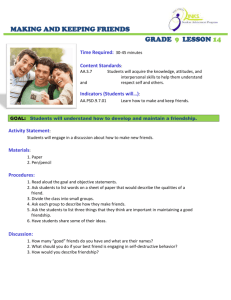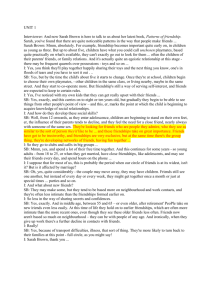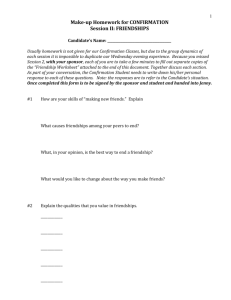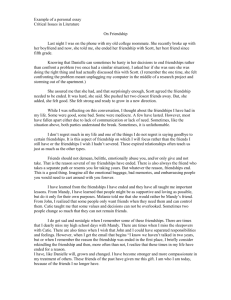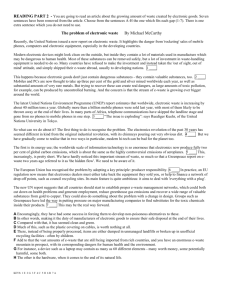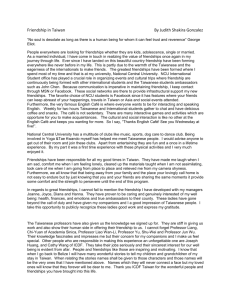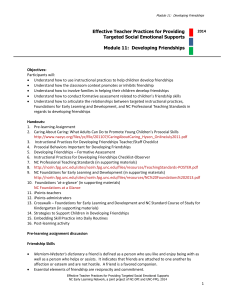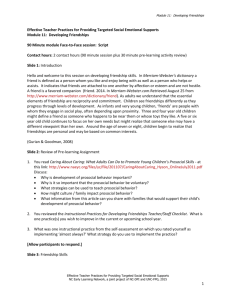Developing Friendships PowerPoint Presentation
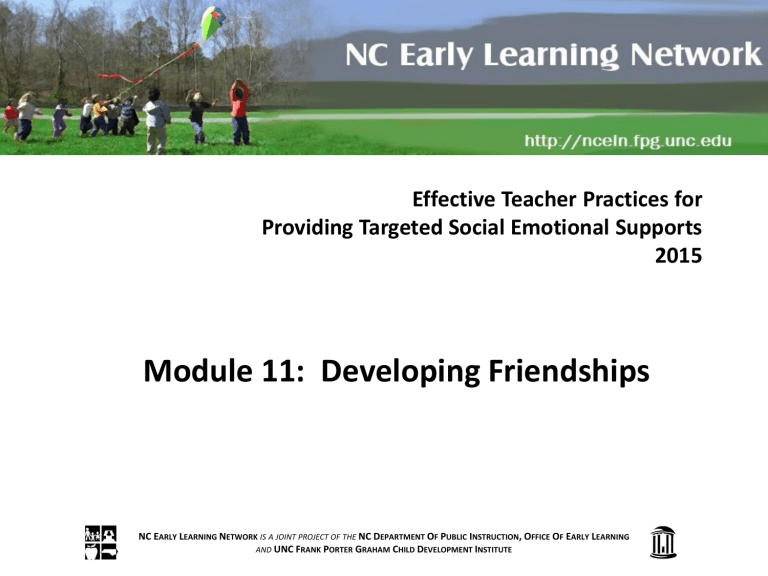
Effective Teacher Practices for
Providing Targeted Social Emotional Supports
2015
Module 11: Developing Friendships
NC E ARLY L EARNING N ETWORK IS A JOINT PROJECT OF THE NC D EPARTMENT O F P UBLIC I NSTRUCTION , O FFICE O F E ARLY L EARNING
AND UNC F RANK P ORTER G RAHAM C HILD D EVELOPMENT I NSTITUTE
Review Pre-learning Assignment
Discuss:
• Why is development of prosocial behavior important?
• Why is it so important that the prosocial behavior be voluntary?
• What strategies can be used to teach prosocial behavior?
• What information from this article can you share with families that would support their child’s development of prosocial behavior?
• What is one practice(s) on the Instructional Practices for
Developing Friendships Teacher/Staff Checklist you wish to improve in the current or upcoming school year?
• What was one instructional practice from the selfassessment on which you rated yourself as implementing ‘almost always?’ What strategy do you use to implement the practice?
2
Friendship Skills
• Write down 3-5 characteristics of a child who gets along with others and makes friends.
• Write down a few short and/or long term outcomes we expect for a child who has these characteristics.
• Write down a few short and/or long term outcomes we expect for a child who does not have these characteristics.
3
Why Friendships Skills are Important
The single best childhood predictor of adult
adaptation is not school grades, and not classroom behavior, but rather, the adequacy with which the
child gets along with other children.
-Willard Hartup, President of International Society for the Study of Behavioral Development
4
Objectives
• Understand how to use instructional practices to help children develop friendships
• Understand how the classroom context promotes or inhibits friendship
• Understand how to involve families in helping their children develop friendships
5
Objectives
• Understand how to conduct formative assessment related to children’s friendship skills
• Understand how to articulate the relationships between targeted instructional practices,
Foundations for Early Learning and Development, and NC Professional Teaching Standards
6
Reciprocity and Lengthy Encounters
7
What Prosocial Behaviors are Important for Developing Friendships?
•
Organizing play
•
Sharing
•
Taking turns
•
Being a team player
•
Giving compliments
•
Giving apologies
8
Formative Assessment
Find handouts:
• Prosocial Behaviors Important for
Developing Friendships
• Developing Friendships-Formative
Assessment
Fill in the first three columns in the chart for your assigned prosocial behavior:
• Determine clear learning target.
• Define criteria for success.
• Determine how you would collect data/documentation and analyze evidence?
9
Instructional Practices Checklist
10
Developing Friendships
11
What Did You Observe?
Instructional Practices Checklist
• What instructional practices did you see?
• What evidence of the practice did you see?
Teaching Standards
• What teaching standards did you see?
• How did the teacher demonstrate these teaching standards?
Foundations Early Learning &
Development Goals
• Which early learning & development goals were children working toward?
• How would you document these skills for the children observed?
http://www.ncpublicschools.org/docs/effectiveness-model/ncees/standards/prof-teach-standards.pdf
12
iPoints
13
Relationship between Foundations and NC Standard Course of Study
Older Preschool
LDC-2: Children participate in conversations with peers and adults in oneon-one, small, and larger group interactions
Kindergarten
Common Core
Speaking & Listening:
Kindergarten:
Participate in collaborative conversations with diverse partners about kindergarten topics and texts with peers and adults in small and larger groups by following agreed upon rules for discussions
14
Family Involvement
15
Setting the Stage
16
Cooperative Use Toys & Materials
17
Planning to Teach Friendship Skills
18
Creating a Friendly Environment
19
Strategies to Support Children in
Developing Friendships
• Review handout titled
Strategies to Support Children in Developing Friendships
Discuss at your table:
• Strategies you use to teach friendship skills/ share examples
• Strategies for supporting children with exceptionalities
• Strategies for imbedding instruction into daily activities
• Strategies for planning with related service personnel
20
Developing Friendships Activity
On your table:
• Find your assigned friendship skill.
• Find your assigned disability or risk factor category.
Materials table:
• Select one item you could use to teach a friendship skill.
In your groups:
• Develop a friendship activity teaching your assigned friendship skill.
• Consider how you would adapt your activity to address your assigned disability or risk category.
21
Planning for Implementation
• Find the Embedding Skill
Practice into Daily Routines handout.
• Select one of the friendship skills listed at the top of the handout.
• Discuss with your partner strategies you can use throughout the day to teach the targeted friendship skill.
• Discuss how you can share this information with other teaching staff and families.
22
Post-learning Activity
• Refer back to the handout titled
Embedding Skill Practice into Daily
Routines you started working on at the end of the Developing
Friendships face-to-face session.
• Review the notes you took on the handout regarding activities to target the development of friendships in your classroom.
• Share this plan with other teaching staff in your classroom and decide how and when you will implement the activities in your classroom.
23
Questions?
24
References
AFIRM Team. (2015). Peer-mediated instruction and intervention. Chapel Hill, NC: National Professional Development Center on Autism Spectrum Disorders, FPG Child Development Center,
University of North Carolina. Retrieved from http://afirm.fpg.unc.edu/peer-mediated-instruction-and-intervention
Bierman, K.L., Torres, M.M., Domitrovich, C.E., Welsh, J.A., & Gest, S.D. (2009). Behavioral and cognitive readiness for school: Cross-domain associations for children attending Head Start. Review of Social Development (Impact Factor 1:56), 18(2), 305-323. doi: 10.1111/j.1467-9507.2008.00490.x
Eisenberg, N., & Fabes, R.A. (1991). Prosocial behavior and empathy: a multimethod, developmental perspective. In M. Clark (Ed.), Review of Personality and Social Psychology (34–61). Newbury
Park, CA: Sage Publishing.
Eisenberg, N., Fabes, R. A. and Spinrad, T. L. (2006). Handbook of Child Psychology, Social, Emotional, and Personality Development (6thed.). Hoboken, NJ: John Wiley & Sons.
Gillanders, C. (2007). An English-speaking prekindergarten teacher for young Latino children: Implications of the teacher-child relationship on second language learning. Early Childhood
Education Journal, 35(1), 47-54.
Guralnick, M.J. (1990). Peer interactions and the development of handicapped children’s social and communicative competence. In H. Foot, M. Morgan, & R. Shute (Eds.), Children Helping
Children (pp.275-305). Sussex, ENG: John Wiley & Sons.
Gurian, A. & Goodman, R.F. (2012, August). Friends and friendships. Retrieved from http://www.aboutourkids.org/articles/friends_friendships
Hartup, W. W. (1992). Having friends, making friends, and keeping friends: Relationships as educational contexts. ERIC Digest [Online]. Retrieved from http://files.eric.ed.gov/fulltext/ED345854.pdf
Hemmeter, M. L., Fox, L. K., & Snyder, P. (2014). Teaching pyramid observation tool (TPOT™) for preschool classrooms manual, research edition. Baltimore, MD: Brookes Publishing Company.
Hyson, M., & Taylor, J. L. (2011). Caring about caring: What adults can do to promote young children’s prosocial skills. Young Children, 66(4). Retrieved from http://www.naeyc.org/files/yc/file/201107/CaringAboutCaring_Hyson_OnlineJuly2011.pdf
Iowa State University Department of Human Development & Family Studies. (2013). Train-Coach-Train. Retrieved from https://iastate.app.box.com/s/9rg5sxh5mfh43da7e05k
25
References
Linder, T. (2008). Administration Guide for TPBA 2 & TPBI 2. Baltimore, MD: Paul H. Brookes Publishing.
NationSwell. (2014, February 12). How one man's trip to Toys 'R' Us brought mobility to hundreds of disabled kids[Video file]. Retrieved from https://www.youtube.com/watch?v=U-NE7B0RTdA
North Carolina Department of Public Instruction. (2012). North Carolina Teacher Evaluation Process. Retrieved from http://www.ncpublicschools.org/docs/effectivenessmodel/ncees/instruments/teach-eval-manual.pdf
North Carolina Foundations Task Force. (2013). North Carolina foundations for early learning and development. Retreived from http://ncchildcare.nc.gov/pdf_forms/NC_foundations.pdf
Odom, S.L., McConnell, S.R., & McEvoy, M.A. (Eds.). (1992). Social competence of young children with disabilities: Issues and strategies for intervention. Baltimore, MD: Paul H. Brookes.
Tabors, P.O. (1997). One child, two languages: A guide to preschool educators of children learning English as a second language. Baltimore, MD: Paul H. Brookes Publishing.
Tremblay, A., Strain, P.S., Hendrickson, J.M., & Shores, R.E. (1981). Social interactions of normal preschool children. Behavior Modification, 5, 237-253.
Warneken, F. & Tomasello, M. (2008). Extrinsic rewards undermine altruistic tendencies in 20-month-olds. Developmental Psychology, 44 (6), 1785-88.
26
